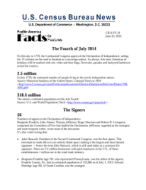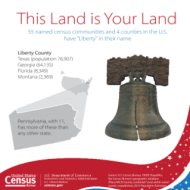Facts for Features: The Fourth of July 2014
On this day in 1776, the Continental Congress approved the Declaration of Independence, setting the 13 colonies on the road to freedom as a sovereign nation. As always, this most American of holidays will be marked with red, white and blue flags, fireworks, parades and backyard barbecues across the country.
2.5 million
In July 1776, the estimated number of people living in the newly independent nation.
Source: Historical Statistics of the United States: Colonial Times to 1970 <//www2.census.gov/prod2/statcomp/documents/HistoricalStatisticsoftheUnitedStates1789-1945.pdf> [PDF - 54.2 MB]
318.4 million
The nation's estimated population on this July Fourth.
Source: U.S. and World Population Clock <//www.census.gov/popclock/>
The Signers
56
Numbers of signers to the Declaration of Independence.
Benjamin Franklin, John Adams, Thomas Jefferson, Roger Sherman and Robert R. Livingston comprised the Committee of Five that drafted the Declaration. Jefferson, regarded as the strongest and most eloquent writer, wrote most of the document. It's also worth noting that:
- John Hancock, President of the Second Continental Congress, was the first signer. This merchant by trade did so in an entirely blank space making it the largest and most famous signature — hence the term John Hancock, which is still used today as a synonym for signature. There are 7.4 million businesses with paid employees in the U.S., of those establishments 1 million are in the retail trade industry.
- Benjamin Franklin (age 70), who represented Pennsylvania, was the oldest of the signers. Franklin County, Pa., had an estimated population of 152,085 as of July 1, 2013. Edward Rutledge (age 26), of South Carolina, was the youngest.
- Two future presidents signed, John Adams (second President) and Thomas Jefferson (third President). Both died on the 50th anniversary of signing the Declaration (July 4, 1826). There are 12 counties nationwide named Adams and 26 named Jefferson.
- Robert Livingston, who represented New York, was on the Committee of Five that drafted the Declaration of Independence but was recalled by his state before he could sign it. Livingston County, N.Y., was home to an estimated 64,705 people as of July 1, 2013.
- Representing Georgia in 1776 were Button Gwinnett, Lyman Hall and George Walton. Gwinnett County, Ga. (859,304), Hall County, Ga. (187,745) and Walton County, Ga. (85,754) were named for these signers.
- Charles Carroll, who represented Maryland, was the last surviving signer of the Declaration. He died in 1832 at the age of 95. Carroll County, Md., named for him, had an estimated population of 167,564 as of July 1, 2013.
- Roger Sherman, who worked as a land surveyor and lawyer, represented Connecticut. Nationally in 2012, there were an estimated 29,976 surveyors, cartographers and photogrammetrists employed full time, year-round, and 841,077 lawyers employed full time, year-round nationwide.
- Nelson County, Va. (14,789) and Wythe County, Va. (29,344) were named for two of the six signers who represented the state of Virginia — Thomas Nelson Jr. and George Wythe.
Sources: TIGER Shapefiles, the Census Bureau's geographic database (Place/MCD/County combined "used within name" count), unpublished, 2012 County Business Patterns and Annual Estimates of the Resident Population: April 1, 2010 to July 1, 2013 <//factfinder2.census.gov/bkmk/table/1.0/en/PEP/2013/PEPANNRES/0100000US.05000.003>
And the Rocket's Red Glare
$203.6 million
The value of fireworks imported from China in 2013, representing the bulk of all U.S. fireworks imported ($213.8 million). U.S. exports of fireworks, by comparison, came to just $10.2 million in 2013, with Israel purchasing more than any other country ($2.7 million).
Source: U.S. Census Bureau, Foreign Trade Statistics, Code 360410 <https://usatrade.census.gov/>
U.S. Flags
$4.0 million
In 2013, the dollar value of U.S. imports of American flags. The vast majority of this amount ($3.9 million) was for U.S. flags made in China.
Source: U.S. Census Bureau, Foreign Trade Statistics, Code 6307909825 <https://usatrade.census.gov/>
$781,222
Dollar value of U.S. flags exported in 2013. The Dominican Republic was the leading customer, purchasing $160,000 worth.
Source: U.S. Census Bureau, Foreign Trade Statistics, Code 6307909825 <https://usatrade.census.gov/>
This Land Is Your Land
Fifty-nine places contain the word "liberty" in the name. Pennsylvania, with 11, has more of these places than any other state. Of the 59 places, four are counties: Liberty County, Ga. (64,135), Liberty County, Fla. (8,349), Liberty County, Mont. (2,369) and Liberty County, Texas (76,907).
Sources: U.S. Census Bureau, TIGER Shapefiles, the Census Bureau's geographic database (Place/MCD/County combined "used within name" count), unpublished and Annual Estimates of the Resident Population: April 1, 2010 to July 1, 2013 <//factfinder2.census.gov/bkmk/table/1.0/en/PEP/2013/PEPANNRES/0100000US.05000.003>
One place has "patriot" in its name: Patriot, Ind., has an estimated population of 205. Source: U.S. Census Bureau, Annual Estimates of the Resident Population: April 1, 2010 to July 1, 2013 <//factfinder2.census.gov/bkmk/table/1.0/en/PEP/2013/PEPANNRES/1620000US1858392>
The most common patriotic-sounding word used within place names is "union" with 136. Pennsylvania, with 33, has more of these places than any other state. Other such words most commonly used in place names are Washington (127), Franklin (118) and Lincoln (95).
Sources: TIGER Shapefiles, the Census Bureau's geographic database (Place/MCD/County combined "used within name" count), unpublished and Annual Estimates of the Resident Population: April 1, 2010 to July 1, 2013.
The British are Coming!
$100 billion
Dollar value of trade in 2013 between the United States and the United Kingdom, making the British, our adversary in 1776, our seventh-leading trading partner today.
Source: U.S. Census Bureau, Foreign Trade Statistics <//www.census.gov/foreign-trade/statistics/highlights/top/top1312yr.html>
Fourth of July Cookouts
62.9 million
Total estimated number of hogs and pigs as of March 1, 2014. Chances are that the pork hot dogs and sausages consumed on the Fourth of July originated in Iowa. The Hawkeye State was home to an estimated 19.8 million hogs and pigs. North Carolina (estimated at 8.0 million) and Minnesota (estimated at 7.8 million) were also homes to large numbers of pigs.
Source: USDA, National Agricultural Statistics Service <//usda01.library.cornell.edu/usda/current/HogsPigs/HogsPigs-03-28-2014.pdf> [PDF - <1.0 MB]
220,521
The number of paid employees (for the pay period including March 12) who worked in a poultry-processing establishment in the U.S. in 2012. There were 517 such establishments — California (45) had the most. Georgia has the most establishments with greater than 1,000 employees (13), followed by Arkansas (11) and North Carolina (8).
Source: U.S. Census Bureau, 2012 County Business Pattern, NAICS 311615 <//www.census.gov/econ/cbp/>
6.1 billion pounds
Total estimated production of cattle and calves in Texas in 2013. There is a good chance that the beef hot dogs, steaks and burgers on your backyard grill came from the Lone Star State, which accounted for nearly one-sixth of the nation's total production. And if the beef did not come from Texas, it very well may have come from Nebraska (estimated at 5.1 billion pounds) or Kansas (estimated at 3.7 billion pounds).
Source: USDA, National Agricultural Statistics Service <//usda.mannlib.cornell.edu/usda/current/MeatAnimPr/MeatAnimPr-04-29-2014.pdf> [PDF - <1.0 MB]
Measuring America
As we celebrate this Independence Day, we reflect on how America's Founders enshrined the importance of statistics in our Constitution as a vital tool for measuring our people, places and economy. Since 1790, the U.S. Census has been much more than a simple head count; it has charted the growth and composition of our nation. The questions have evolved over time to address our changing needs. Today, the 10-year census, the economic census and the American Community Survey give Congress and community leaders the information they need to make informed decisions that shape our democracy. These statistics are how we know how our country is doing.
Visit <//www.census.gov/how> to view and to learn more about "How Do We Know?" Follow @uscensusbureau on Facebook, Twitter, Flickr, YouTube and Pinterest (#HowDoWeKnow) for updates.
The following is a list of observances typically covered by the Census Bureau’s Facts for Features series:
| Black (African American) History Month (February) Super Bowl Valentine's Day (Feb. 14) Women's History Month (March) Irish-American Heritage Month (March)/ St. Patrick's Day (March 17) Earth Day (April 22) Asian/Pacific American Heritage Month (May) Older Americans Month (May) Mother's Day Hurricane Season Begins (June 1) Father's Day |
The Fourth of July (July 4) Anniversary of Americans With Disabilities Act (July 26) Back to School (August) Labor Day Grandparents Day Hispanic Heritage Month (Sept. 15-Oct. 15) Unmarried and Single Americans Week Halloween (Oct. 31) American Indian/Alaska Native Heritage Month (November) Veterans Day (Nov. 11) Thanksgiving Day The Holiday Season (December) |
Editor’s note: The preceding data were collected from a variety of sources and may be subject to sampling variability and other sources of error. Facts for Features are customarily released about two months before an observance in order to accommodate magazine production timelines. Questions or comments should be directed to the Census Bureau’s Public Information Office: telephone: 301-763-3030; or e-mail: [email protected].





